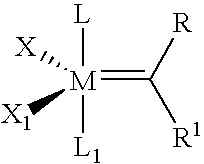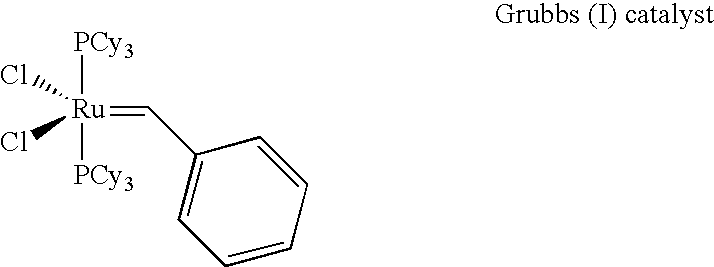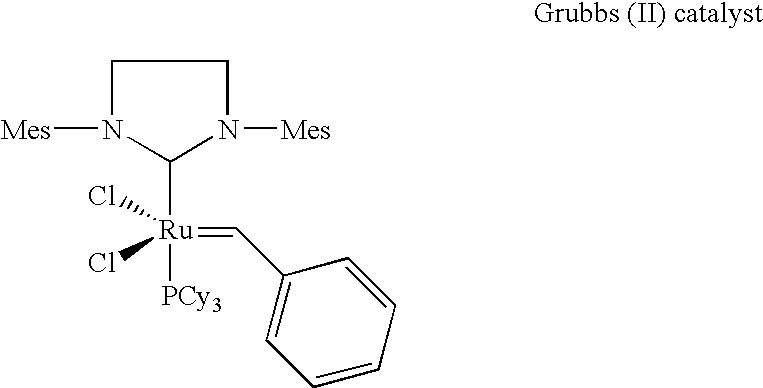Method for the degradation of nitrile rubber by metathesis in the presence of ruthenium- or osmium-based catalysts
- Summary
- Abstract
- Description
- Claims
- Application Information
AI Technical Summary
Benefits of technology
Problems solved by technology
Method used
Image
Examples
examples
I Synthesis of Catalysts used According to the Invention
[0087] [dichloro(1,3-dimesityldihydroimidazolylidene)(tricyclohexylphosphoniocarb-ene)ruthenium] tetrafluoroborate (2) in B2; [0088] [dichloro(1,3-dimesityldihydroimidazolylidene)(tricyclohexylphosphoniocarb-ene)ruthenium] [tetrakis(3,5-trifluoromethylphenyl)borate] (3) in B3 [0089] [dichloro(4,5-dibutyl-1,3-dimesityldihydroimidazolylidene)(tricyclohexylphos-phoniocarbene)ruthenium] tetrafluoroborate (6) in B8
B1 Carbido(dichloro)-1,3-dimesityldihydroimidazolylidene(tricyclohexylphosphine) ruthenium (1)
[0090] (1,3-Dimesityldihydroimidazolylidene)(PCy3)Cl2Ru=CHPh (0.42 g; 0.5 mmol) and diethyl trans-3-methylene-1,2-cyclopropanedicarboxylate (0.10 g; 0.5 mmol) were placed in a 25 ml Schlenk vessel. Under nitrogen as protective gas, dry CH2Cl2 (5 ml) was added and the reddish brown solution was stirred for 12 hours. The solvent was then taken off from the resulting orange-brown solution in a high vacuum. Under nitrogen, the b...
PUM
| Property | Measurement | Unit |
|---|---|---|
| Temperature | aaaaa | aaaaa |
| Temperature | aaaaa | aaaaa |
| Temperature | aaaaa | aaaaa |
Abstract
Description
Claims
Application Information
 Login to View More
Login to View More - R&D
- Intellectual Property
- Life Sciences
- Materials
- Tech Scout
- Unparalleled Data Quality
- Higher Quality Content
- 60% Fewer Hallucinations
Browse by: Latest US Patents, China's latest patents, Technical Efficacy Thesaurus, Application Domain, Technology Topic, Popular Technical Reports.
© 2025 PatSnap. All rights reserved.Legal|Privacy policy|Modern Slavery Act Transparency Statement|Sitemap|About US| Contact US: help@patsnap.com



